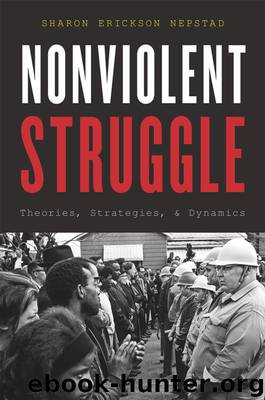Nonviolent Struggle: Theories, Strategies, and Dynamics by Sharon Erickson Nepstad

Author:Sharon Erickson Nepstad [Nepstad, Sharon Erickson]
Language: eng
Format: azw3
Publisher: Oxford University Press
Published: 2015-08-31T16:00:00+00:00
Longer-Term Outcomes
Numerous studies have shown that civil resistance can destabilize and overturn regimes, particularly autocratic ones. Yet getting rid of a bad political system does not automatically mean that a movement is capable of instituting a new and improved system. In fact, a number of political analysts have expressed doubts about the capacity of nonviolent movements to establish democracies. For instance, Haynes wrote, “[W]hile authoritarian regimes may be overthrown by mass mobilization, this is not likely to result in their replacement by stable liberal democratic regimes.”43
But what does the empirical evidence show regarding the long-term effects of nonviolent action? Are political transitions that happen through nonviolent means more likely to produce stable democracies? Or does civic disruption lead to a more chaotic political environment that creates new conflicts and tensions? Several recent studies show that, overall, nonviolent movements are more likely than violent movements to secure democratic consolidation, political stability, and economic growth.
Download
This site does not store any files on its server. We only index and link to content provided by other sites. Please contact the content providers to delete copyright contents if any and email us, we'll remove relevant links or contents immediately.
Cecilia; Or, Memoirs of an Heiress — Volume 1 by Fanny Burney(31444)
Cecilia; Or, Memoirs of an Heiress — Volume 3 by Fanny Burney(31036)
Cecilia; Or, Memoirs of an Heiress — Volume 2 by Fanny Burney(30982)
The Great Music City by Andrea Baker(22896)
We're Going to Need More Wine by Gabrielle Union(18125)
Bombshells: Glamour Girls of a Lifetime by Sullivan Steve(13157)
Pimp by Iceberg Slim(12999)
All the Missing Girls by Megan Miranda(12834)
Fifty Shades Freed by E L James(12491)
Talking to Strangers by Malcolm Gladwell(11984)
Norse Mythology by Gaiman Neil(11961)
Crazy Rich Asians by Kevin Kwan(8410)
Mindhunter: Inside the FBI's Elite Serial Crime Unit by John E. Douglas & Mark Olshaker(7897)
The Lost Art of Listening by Michael P. Nichols(6532)
Enlightenment Now: The Case for Reason, Science, Humanism, and Progress by Steven Pinker(6447)
Bad Blood by John Carreyrou(5816)
The Four Agreements by Don Miguel Ruiz(5577)
Weapons of Math Destruction by Cathy O'Neil(5096)
We Need to Talk by Celeste Headlee(4920)
